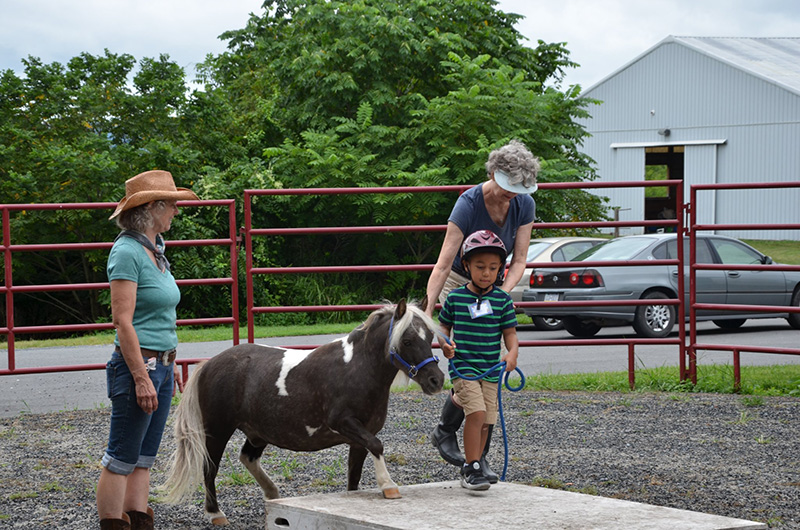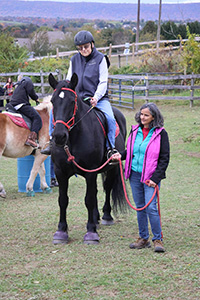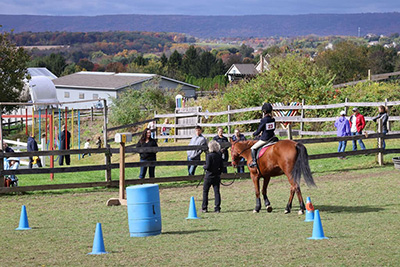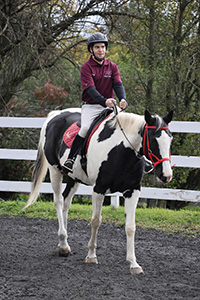
A child interacts with one of the miniature therapy horses at Equi-librium, a premier accredited therapeutic horsemanship center in Nazareth, Pennsylvania.
Equi-librium is a premier accredited therapeutic horsemanship center in Nazareth with the mission of helping individuals reach their highest potential through the benefits of horse-related activities and therapies. Through equine-assisted services, we help individuals of all ages and in all stages of life with physical, developmental, and behavioral/mental health disabilities and challenges.
While Equi-librium’s history dates back to the 1980s, we have been in the Lehigh Valley for just over 10 years. We have 16 horses, are assisted by more than 200 volunteers annually, and serve more than 130 participants every week. We also do outreach focused on education and mental health with our miniature therapy horses.

What do you love most about your job and organization?
Absolutely everything. The Equi-librium farm is set on 18 tranquil acres and is home to not only magnificent horses but also ducks, cats, and wildlife. There’s nothing quite like working at a place like this. Plus, getting to witness the transformative power of equine-assisted services and the bonds between horses and humans is truly a gift. Physical, social, and developmental milestones are reached here every single day, which means every day is a cause for celebration.
The other part of my job that I love is getting to connect with the community. We have a unique resource here in the Lehigh Valley as the only accredited center of our kind with certified professional staff and specially trained horses. I think it’s a privilege to have this resource, and therefore it’s our responsibility to make sure that we are making the most of it in our community. My favorite part of leading an organization like this is when I get to reach out to other nonprofit organizations doing absolutely amazing things and say, “We’ve got this incredible resource; can we share it with you?” We’ve made so many meaningful connections with organizations serving children in foster care, people with disabilities and serious illnesses, and more.
How does Moravian University support your mission?
Moravian University and its students are truly powerful forces in our community, and we’ve been lucky enough to call on the university and its student body for some of our vast volunteer needs.
Any given week, we have upwards of 175 unique volunteer slots to fill. This does not include help with major facilities projects necessary for the upkeep of our farm, or special events that are significant fundraisers for our programs. Moravian University—and the equestrian team, in particular—has helped us with many of these projects.

How can Moravian University—and the greater community—be more involved with your organization?
We rely very heavily on the power of volunteerism and the time donated by passionate individuals in our community. In any given therapeutic riding lesson, we might use up to 12 unique volunteers. In this way, volunteers far outnumber our instructors, therapists, and administrative team. There are countless volunteer opportunities, including helping with programs, office work, committees, horse care, and more.
Fundraising is also an extremely important pillar of our organization, and another area where we look to the community. Approximately 60 percent of all program/operational costs and 100 percent of capital expenses are covered by donations, grants, and event sponsorship. These donations allow for the care and keeping of our horses, the upkeep of our barns and program facilities, and the advanced certifications and training required of our instructors to ensure safe and quality programming. No fundraising idea is too big or too small.

What is the biggest challenge your organization faces?
Our biggest challenge is providing affordable and accessible services to our community while our expenses continue to increase. Horses are expensive, and the expenses associated with maintaining 18 acres of land and buildings that date back to the 1850s are not small. The costs of hay, veterinary care, feed, and medications continue to rise year after year, yet we strive to keep program rate increases to a minimum and create avenues for low-income families to access our services.
What are your hopes for the future of your organization?
My hope and my goal is to maintain the integrity of our core values while also remaining flexible to the expansive needs of our community. For instance, we have seen a sharp increase in mental health diagnoses, now surpassing physical disabilities. The demand for service is there, so it’s up to us to put in the work to grow and develop to meet that need. I also envision a future where therapeutic programs are accessible to those in need regardless of ability to pay a fee for service and where collaboration with other organizations can thrive. It’s not just a hope; it’s a goal I’m working toward.
—Jessie Shappell, executive director